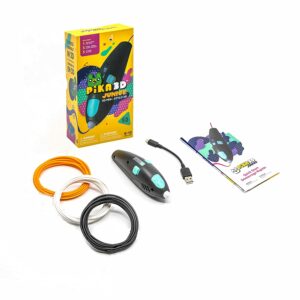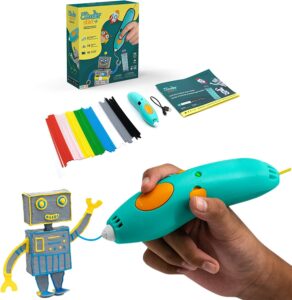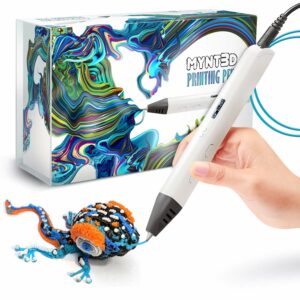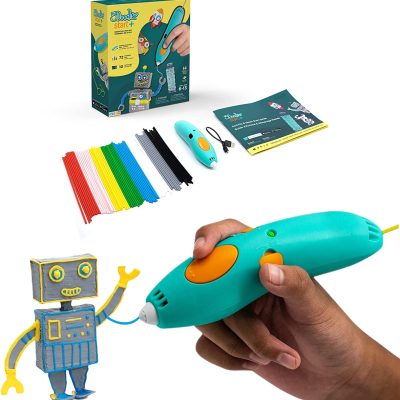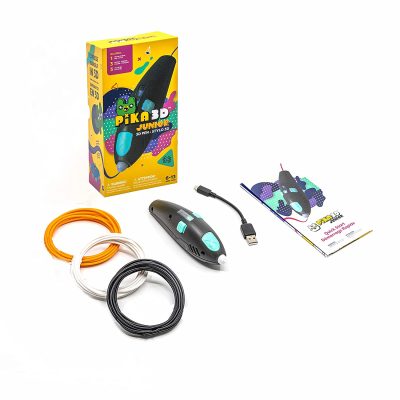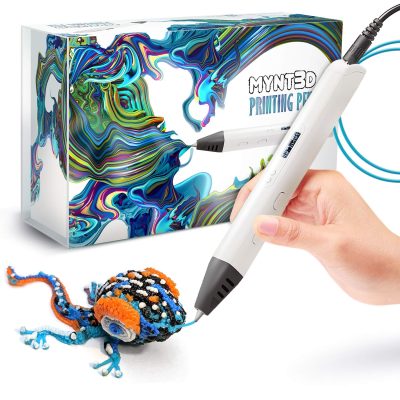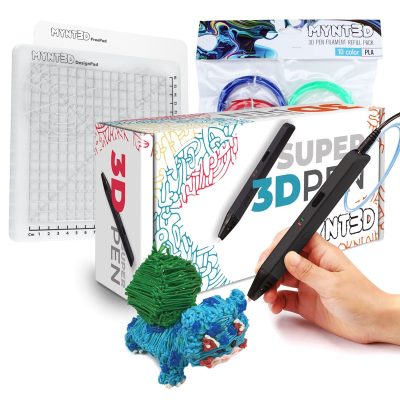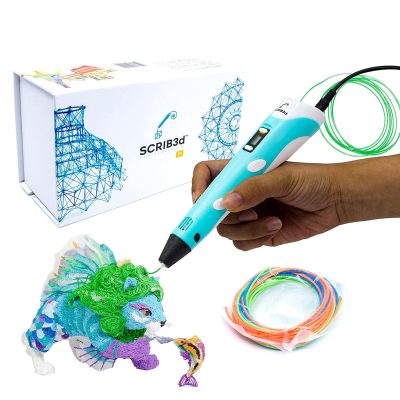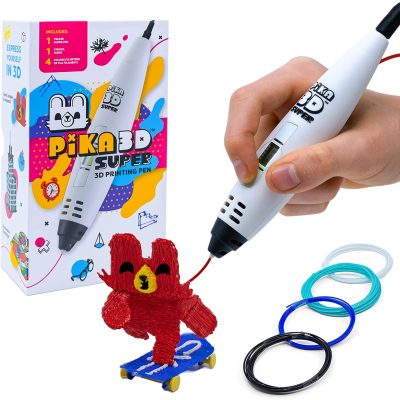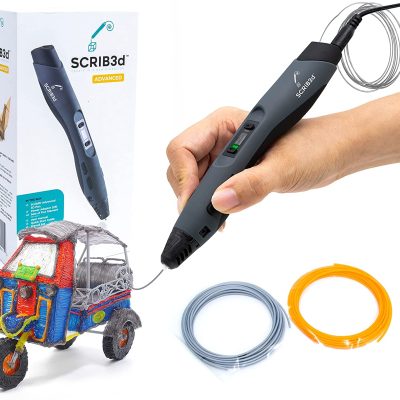- Last Updated: January 12, 2024
-
 Pat Nathaniel
Pat Nathaniel
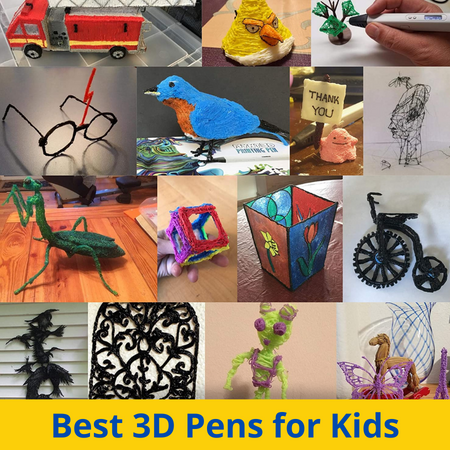 Do your kids like drawing or crafts? Then they’ll love a 3D pen!
Do your kids like drawing or crafts? Then they’ll love a 3D pen!
A 3D printer pen is a great art gadget that allows your kid to take their flat drawing to the third dimension. While they have fun doodling, they’ll also exercise their critical thinking while they explore how 3D space works.
Fun and educational — what could be better?
But there are a lot of 3D pens on the market. It’s all too easy to waste money on a pen that’s too challenging or unsafe for your child to use.
Nobody wants that, so we put together this list of the best 3D pens for kids to help you find a pen your child will love.
Table of Contents
Best 3D Pens for Kids At A Glance
1. 3Doodler Start+ (Best Choice)
2. PIKA3D Junior (Best Value)
3. MYNT3D Professional (Premium Choice)
4. MYNT3D Super (Most Reliable)
5. SCRIB3D P1 (Most Versatile)
6. PIKA3D P1 (Best Gift Set)
7. SCRIB3D Advanced (Best for Older Kids)
Materials: 3Doodler Eco-Plastic | Filament Diameter: 2.5 mm | Feature Highlights: No Hot Parts, Kid-Safe Filament & Wireless
Want everything you need to introduce your kids to 3D pens? 3Doodles Start+ is the best complete 3D pen set out there.
This introductory 3D pen kit includes the pen, a nice variety of filament strands, a charger cable, and a handy activity guide with stencils. Your kid can get started on the fun in minutes.
But the best thing about 3Doodler is the safety.
The pen features no external hot parts. Additionally, the molten plastic is safe to touch straight from the nozzle. There’s no need to worry about burns or other booboos.
The filament is made of certified non-toxic, food-grade plastic. The material is also biodegradable, so you can safely dispose of failed (or should we say extra creative) 3D doodles.
The pen has a simple one-click operation, so even young 3D designers can use it with ease. It’s also nice and colorful to please their distinguished tastes — although older kids might find it a bit childish.
As a cherry on top, the pen is wireless. Small kids can easily manipulate it without getting tangled in a cord.
Note that the low-temperature pen is intended to work only with 3Doodler’s proprietary Eco-Plastic filaments. As such, getting new strands can get pricey.
Still, 3Doodler Starter+ is the best way to get your kid into 3D pens.
Pros
- Safe design
- Wireless
- Good value
- Ease of use
Cons
- Pricey filament
- Short battery life
- Toy-like appearance
Technology: FDM | Materials: PCL | Filament Diameter: 2.5 mm | Feature Highlights: Low Price, No Hot Parts & Kid-Safe Filaments
Not sure if your kid’s interest in 3D pens will last? Or are you just on a budget? No worries — PIKA3D Junior is a budget-friendly entryway to 3D pens.
In the affordable package are the 3D pen, a charger, and three long filament spools. In other words, all your kid needs to get creative in three dimensions.
Like the 3Doodler, PIKA3D Junior has no hot parts. Even the low-temperature nozzle won’t burn on skin contact. Safe and fun, what could be better?
The low-temperature PCL filament is non-toxic, so your kid can safely exercise their creativity. And, just like with 3Doodler, it’s biodegradable. You can throw away accidental messes without worrying about the environment.
You’ll have to use PIKA3D’s filaments, though. PCL material and the filament’s diameter are pretty exotic, so you’re unlikely to find third-party alternatives.
But the good news is that the refill pack is also reasonably priced. PIKA3D’s spools also contain 9.8 feet of filament, so one will keep your kid printing for a long time.
Until they want to make truly 3D objects, that is. PIKA3D is a great introductory pen, but it was probably never intended for advanced creations.
That said, PIKA3D Junior serves up hours of creative fun at a low price.
Pros
- Affordable
- Safe pen and filaments
- Wireless
Cons
- Proprietary filaments
- Not for advanced use
- Some users report battery issues
Technology: FDM | Materials: PLA & ABS | Filament Diameter: 1.75 mm | Feature Highlights: OLED Display & Material Support
Kids who have already used a couple of 3D pens or two might want something more powerful. MYNT3D Professional lets even the most demanding 3D pen user have fun.
This 3D pen comes packed with advanced features. To begin with, it uses real, pro-grade plastic filaments.
MYNT3D Professional has an adjustable heating range that melts any plastic designed for temperatures between 140-230°C. It can work with PLA, ABS, or any other filament that melts in those temps.
In other words, your kid won’t be limited to just kids’ materials.
Controlling the temperature is easy with dedicated buttons and a clear OLED display showing how hot the pen runs. You can also control the filament feed rate to get the best results.
More advanced filaments could degrade the tip over time — but that’s okay. Thanks to a replaceable ultrasonic sealed nozzle, this pen keeps your kid creating for a long time.
Essentially, MYNT3D isn’t a toy. It’s a pro-grade FDM 3D printing pen that lets your kid explore challenging artistic or engineering endeavors.
That also means that this 3D pen isn’t for small kids. The nozzle can clog easily with incorrect settings. Additionally, the pen and materials are on the pricier side, but that’s to be expected for a professional tool.
MYNT3D Professional is a tailor-made tool for older kids serious about 3D printing.
Pros
- Wide material support
- Speed and temperature controls
- Temperature display
- Light and slim
Cons
- Pricey
- Tends to clog
- Wired design
Technology: FDM | Materials: PLA & ABS | Filament Diameter: 1.75 mm | Feature Highlights: Temperature Control, Speed Slider,& Anti-Clog Nozzle
MYNT3D delivers a double whammy with the Super 3D pen. If the Professional version is a bit too hardcore for your kid or budget, the Super 3D pen delivers power and reliability that’s simply super.
At its core, MYNT3D Super is the same pen as the Professional version. Think of the two as a bigger and younger sibling, if you’d like!
MYNT3D Super boasts the same sealed nozzle and temperature and speed controls as its big brother. That means it can create gorgeous, high-quality works with PLA or ABS.
It also has the same sealed nozzle design with anti-clog features. As long as you dial the temperature correctly, MYNT3D Super is a reliable, low-maintenance 3D pen.
Unfortunately, it doesn’t have its big brother’s OLED display, so determining the temperature is a bit tricky. You also have to use the provided micro-screwdrivers to turn the temperature control screw, which is a bit of a hassle.
All in all, MYNT3D Super delivers everything the Pro pen does, only in a more budget-friendly package. It has a steeper learning curve, but at the same time, it’ll keep working reliably for hours of 3D printing fun.
Pros
- Speed and temperature controls
- Material support
- Reliable
- Replaceable nozzle
Cons
- Difficult temperature screw
- Learning curve
- Wired design
Technology: FDM | Materials: PLA & ABS | Filament Diameter: 1.75 mm | Feature Highlights: LCD Display & Temperature Control
Some of the best family moments come from shared activities. SCRIB3D P1 is a versatile device that lets the whole family get in on the fun.
That’s just how powerful and easy to use it is.
The brightly colored pen is pleasing to kids’ eyes and simple to use. With filament extrusion and retraction buttons, printing filament is a one-button job with this 3D pen.
But the advanced controls let both older kids and even adults flex their creative muscles. The P1 works with both PLA and ABS plastic. Thanks to a clear LCD display and control buttons, you can easily set the temperature.
The pen also has an adjustable speed slider. That, and the ceramic anti-clog nozzle should keep the hot end free of obstructions.
In short, the P1 suits both small kids making their first 3D creation and their parents who want to fix a damaged PLA 3D print.
This 3D pen is also affordable so you won’t break the bank with it. Unfortunately, the low price shows in that it can struggle to maintain steady temperatures, which can lead to print flaws. Some of the buttons are also placed a bit unintuitively.
But when it comes to value and versatility, SCRIB3D P1 is the best 3D pen for kids and adults.
Pros
- Lightweight
- Simple usability
- Material options
- Suits every user
- Affordable
Cons
- Cheap build quality
- Button placement
- Fluctuating temperature
- Wired design
Technology: FDM | Materials: PLA & ABS | Filament Diameter: 1.75 mm | Feature Highlights: OLED Display & Temperature Controls
If you’re buying a 3D pen as a gift for your kid, you need to consider everything that comes in the package — not just the pen. PIKA3D Super is a complete gift set that gets your kid 3D doodling quickly and easily.
The 3D pen itself is a step up from the PIKA3D Junior featured earlier. Unlike its smaller sibling, the Super pen works with regular-diameter ABS and PLA plastic filament types.
Since it works with basic filaments, buying more material for this pen is much more affordable. The set has four spools of PLA, totaling 39 feet, so you won’t have to shell out for more anytime soon.
The pen has a clear OLED screen and simple temperature controls to keep the filament flowing. The design is lightweight, although the bulbous shape is a bit awkward to hold.
On top of the pen and filament, you’ll also get a charger, user manual, quick start guide, and some stencils. In other words, everything your kid needs!
Kids of all ages can have fun with this pen, but the button placement can be too wide for smaller fingers. Additionally, the Super pan has a continuous filament feed, meaning it keeps extruding or retracting the material until you press the button again. Unlike the Junior, this pen is also not wireless.
The PIKA3D Super is a great gift set that brings a lot of value to your kid.
Pros
- Well-stocked package
- Lightweight
- Temperature control
- OLED display
- Material support
Cons
- Bulbous shape
- Awkward button placement
- Wired design
Technology: FDM | Materials: PLA & ABS | Filament Diameter: 1.75 mm | Feature Highlights: LCD Screen, Temperature & Speed Controls
As kids age, they tend to want more advanced toys. SCRIB3D Advanced is a great 3D pen for older and more experienced 3D creators.
You’ll know the name of the game as soon as you pull the pen out of its packaging. The sleek, ergonomic design and gray coloring just scream, “I’m a professional.”
The professionalism isn’t just about looks, though. SCRIB3D Advanced has everything you’d want in a full-featured 3D pen, from temperature adjustment to an eight-step speed selector.
The pen heats hot enough to process both PLA and ABS plastic filament for advanced 3D doodling. The button placement is much better than in SCRIB3D P1, and the ergonomic design is comfortable to hold.
As a nice touch, the large LCD screen has a battery level indicator. It will also throw an ERROR message if your kid manages to clog the anti-clog nozzle. That can keep your kid from accidentally breaking the pen.
As we said — a total professional.
That also means that this pen isn’t the easiest to use. Older kids will like it, but young artists should probably start with a simpler tool.
Some users also report that the automatic sleep function might not be as automatic as it seems. Maybe that’s just a bug, but tell your kid to keep an eye on the 3D pen when they set it down.
SCRIB3D Advanced is exactly what it says on the label — an advanced 3D pen for an advanced 3D doodler.
Pros
- Professional look
- Ergonomic design
- Temperature and speed adjustment
- Material options
- Great LCD screen
Cons
- Challenging to use
- Slow heat-up
- Wired design
The Perfect Gift for a Creative Kid
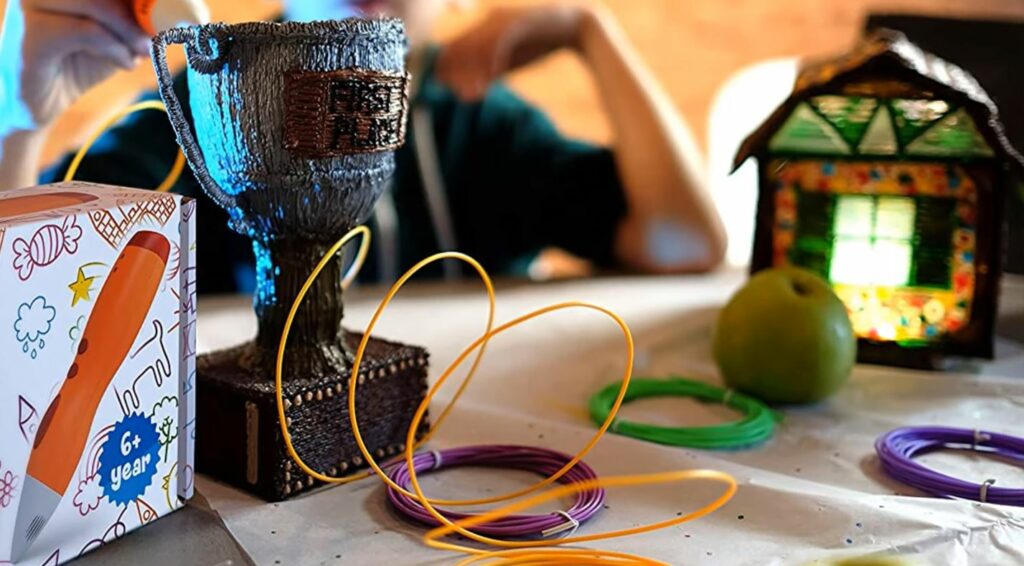
If your kid is the creative sort, they’re sure to love a 3D pen. 3D pens offer them a whole new creative medium that lets them bring their drawings to life.
3D pens are fun little devices that provide countless hours of engaging activity. And they’re educational, too!
A 3D pen can support STEM learning by letting your kid explore how objects function in three-dimensional space. They’re also a great stepping stone to full-fledged 3D printers for future engineers.
But picking the best 3D printing pen for your kid can be tricky. The market is saturated with seemingly similar pens. You should make sure that you get a 3D pen that’s safe enough but still gets your kid’s creative juices flowing.
Let’s take a closer at what 3D pens are and what you should consider before buying one.
Are 3D Pens Safe for Kids to Use?
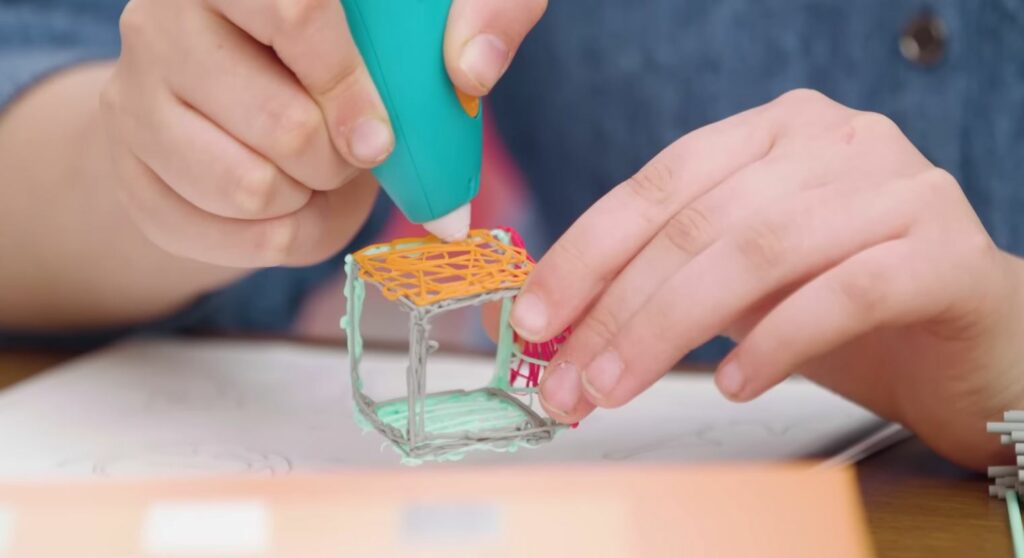
First, we should address the elephant in the room. In general, 3D pens are safe for kids to use.
That said, keep a couple of considerations in mind. Most 3D pens need to heat up to melt the plastic filaments they consume.
Some of them could burn a careless user or a table surface.
To help with this issue, pens for the youngest kids don’t usually have external hot parts. Many also have automatic shut-off or sleep features so the hot pen doesn’t sit around for hours.
Then there’s the matter of the plastic material. Most 3D pens for kids come with non-toxic materials, so you won’t have to worry about a curious child checking what the toy they just printed tastes like.
Melting plastic can also release some fumes. In the case of 3D pens, these fumes aren’t toxic, but it’s always best to use the pen in a well-ventilated space.
What to Know Before you Buy a 3D Pen for Kids?
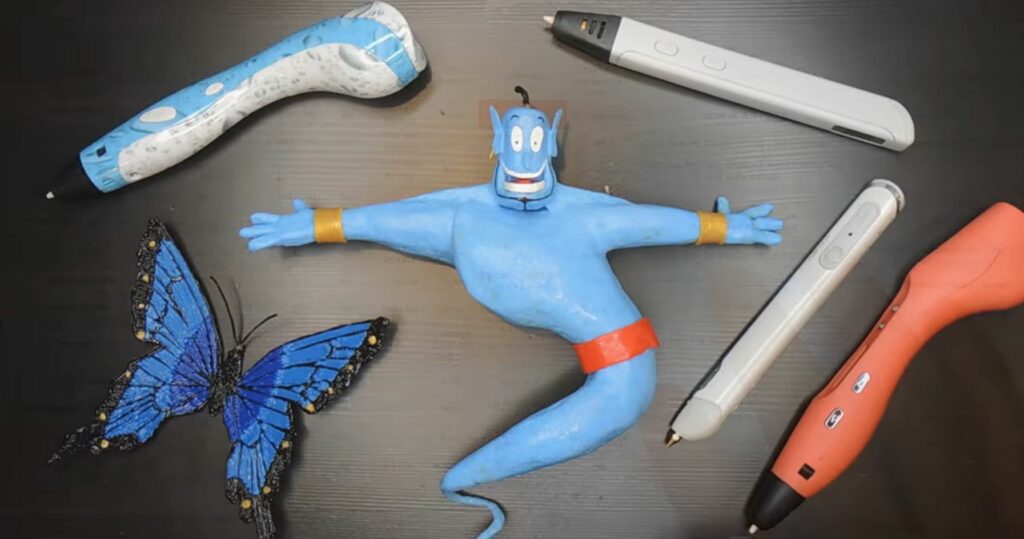
Before you buy your kid a 3D pen, you should know what you’re getting into.
3D pens are pen-like devices that extrude a thermoplastic material. The material generally comes as filaments that feed into the pen through an entry slot on the handle, though some pens use UV-cured inks.
The pen pushes the material through a nozzle at the tip. By piling the plastic as layers, your kid can create three-dimensional artwork, objects, and even toys.
Essentially, using a 3D pen is kind of like frosting a cake!
The best 3D pens challenge your kid’s creativity with an entirely new dimension. They can create fun objects while also considering the physics of three-dimensional space. They’ll learn without even realizing it.
Types of 3D Pens
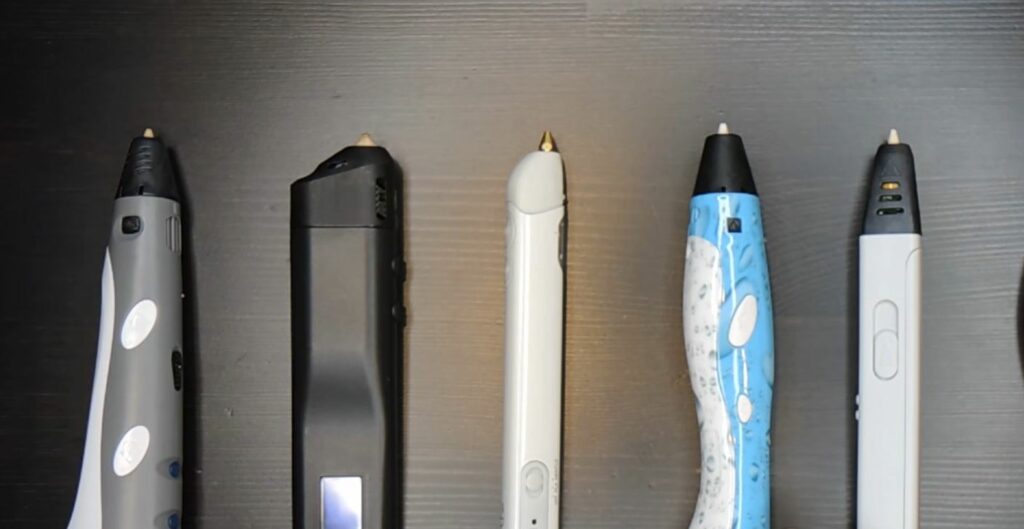
Not every 3D pen on the market works the same way. In general, the pens that are simple enough for kids to use fall into one of these four categories:
- FDM: Fused deposition modeling (FDM) is the most common 3D printing technology. These pens melt plastic filaments and extrude them through a nozzle.
- Low Temperature: Low-temp 3D pens are simply FDM pens that don’t run as hot. That limits their material options but also makes them much safer for small children.
- Cool Ink with Internal UV: Instead of filaments, these pens use liquid photopolymer inks that cure into a solid under UV light. Cool ink pens don’t have any hot parts, so they’re safer but also more expensive and difficult to use.
- Cool Ink with External UV: External UV cool ink pens work like internal UV ones, but they rely on an external lamp or another device to provide the UV light necessary to cure the ink.
What’s the Difference Between a 3D Pen and a 3D Printer?
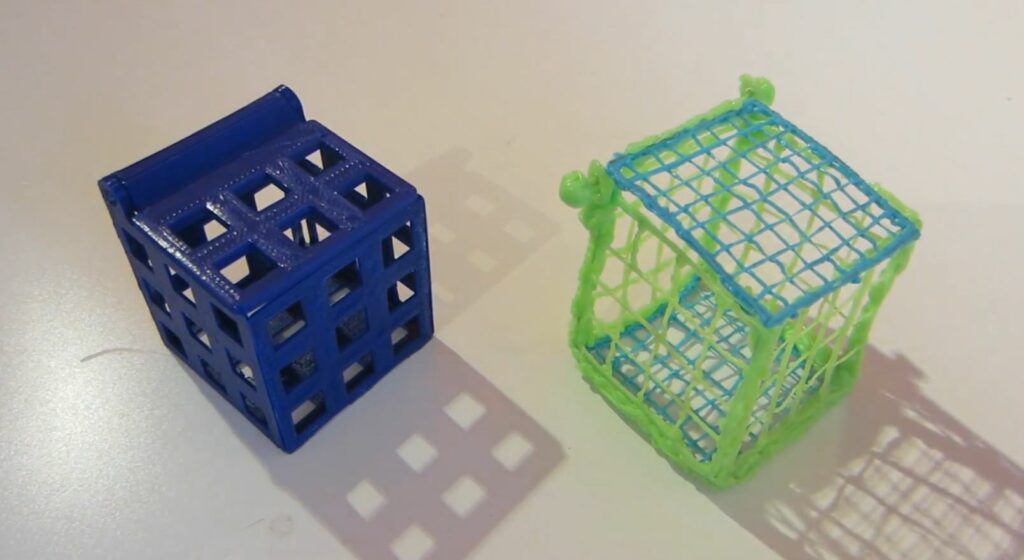
You could argue that there’s really no difference between a 3D pen and a 3D printer. A 3D pen is essentially a small, handheld 3D printer, after all.
In practice, though, there’s a pretty clear distinction between the two.
3D pens are generally ready to go straight out of a package. They’re affordable and simple to use, even for small kids.
Meanwhile, 3D printers are more expensive and complex. They’re stationary machines that require careful calibration and print preparation. The printing process is automated and runs independently after you press the Start button.
3D printers are most likely too complicated for children — especially small ones — to use on their own. That said, even a cheap 3D printer will probably produce neater parts than the most steady-handed 3D pen user.
How to Choose the Right 3D Pen for Your Kid
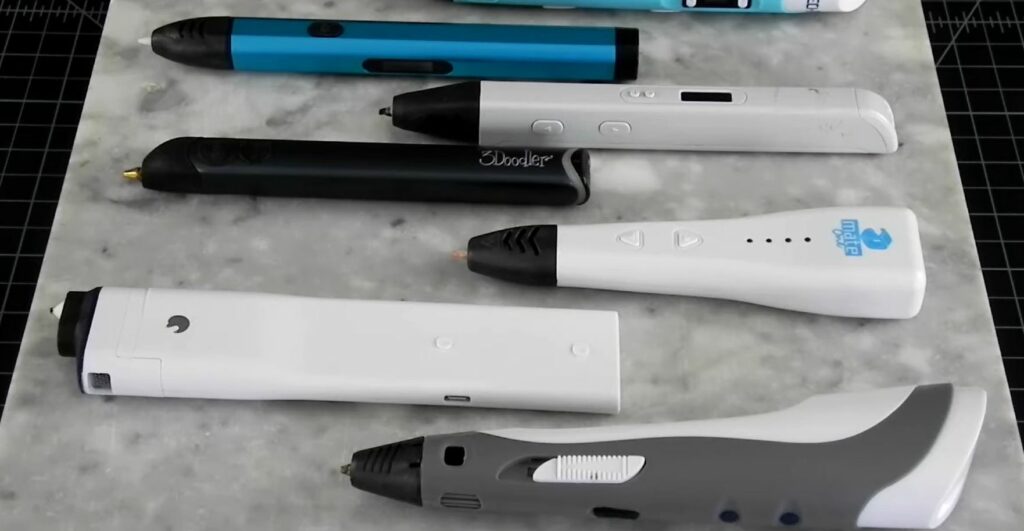
Are you still feeling at a loss over which 3D pen you should pick for your kid? Here are the most important things to consider when choosing a pen.
Design
The slimmer and lighter the 3D pen is, the easier it is to handle — especially for small hands. Pay attention to the size of the pen, ergonomics, and button placement to make sure your kid can hold and use the pen comfortably.
Settings
Some 3D pens allow you to tweak settings like printing temperature, extrusion speed and direction, and more. Meanwhile, others only have a single ON/OFF button. Consider your kid’s age and skill level when choosing what settings the pen should have.
Materials
Different kinds of filaments melt at different temperatures, so think about what materials the pen should be able to process. PCL is a low-temperature material that’s safe for young artists, while more advanced plastics — like ABS and PLA — melt at higher temperatures.
Corded or Cordless
A power cord can make a big difference to how comfortable the pen is to handle, particularly for small children. A wireless pen is easy to handle without getting tangled in a cord, but also comes with limited battery life.
Safety
Some 3D pens heat up to very hot temperatures to melt advanced plastics. A low-temperature or cool ink pen can help young children avoid burning themselves or others. Older kids can safely handle a hotter, more advanced pen.
Reliability
Pay attention to user reports on how reliable the 3D pen is. Molten plastic can clog the nozzle, requiring a long and annoying cleaning process. Pick a pen with good reviews that runs at a steady temperature.
Price
Finally, consider how much money you want to spend on the pen. 3D pens aren’t all that expensive, but you still don’t want to spend money on features your kid is unlikely to ever use. It may be a good idea to start with a simple pen and upgrade to a more expensive one if your kid gets into 3D doodling.
Fuel Your Kid’s Creativity
A 3D pen is a fun, educational gadget that can keep your kid engaged for hours. Just pick a pen that fits your kid’s age and skills, and you’re good to go.
Should you still be unsure about your choice, here are our top recommendations:
- 3Doodler Start+ is the best 3D pen for kids of all ages.
- PIKA3D Junior is a great value package for young children.
- MYNT3D Professional has the power older kids and serious artists need.
- SCRIB3D P1 offers enough versatility for the whole family.
Related Articles:
- Best 3D Pens (Adults & All Ages)
- 3D Pen Ideas & Art




